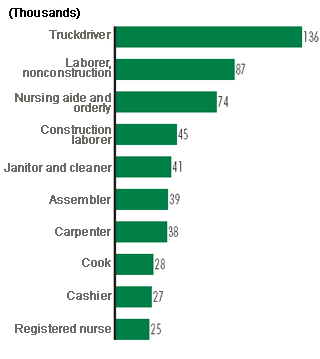|
You live in the present and plan for the future. Why
study the past? Career options, for starters.
Earning a degree in history provides opportunities in a
wide range of fields. Advocacy historians, for example,
may become paralegals and lawyers, litigation support
personnel, and legislative staff members. In information
management, historians may work as archivists, records
managers, and librarians. And historians in communications
might work as writers and editors, journalists, and
producers of multimedia materials.
The American Historical Association posts on its Web
site several reports and essays of interest to history
majors and historians. Topics range from "Redefining
Historical Scholarship" to "Why Study
History?" The Association also sells numerous
publications. Titles include "The Constitution and
Economic Change," "Ethnicity and
Immigration," and "Intellectual and Cultural
History." For more information, contact the
Association, 400 A St. SE., Washington, DC 20003-3889;
(202) 544-2422. To visit its Web site, set your browser to
www.theaha.org.
|
Do workers during their early employment years hold more
jobs, stay in those jobs for shorter periods, and experience
rapid growth in earnings? They did if they’re baby
boomers, according to a Bureau of Labor Statistics (BLS)
longitudinal survey conducted between 1979 and 2000.
Among the findings were that workers born between 1957
and 1964—the latter part of the 1946-64 "baby
boom" in the United States—held an average of nearly
10 jobs from ages 18 to 36. Between ages 18 and 22, workers
held about 4 jobs. The number of jobs held decreased as
workers got older: just over 3 for workers aged 23 to 27,
fewer than 3 for those aged 28 to 32, and 2 for workers aged
33 to 36. Job changes varied by sex and race or ethnic
group.
Other data show that when they were young, surveyed
workers were in their jobs for shorter periods than they
were as they got older. For example, about 72 percent of the
jobs that workers began when they were aged 18 to 22 ended
in less than a year, and 94 percent ended in fewer than 5
years. In contrast, 43 percent of the jobs begun by the
workers when they were 33 to 36 years old ended in less than
1 year, with 76 percent ending in fewer than 5 years.
The survey also found that workers’ inflation-adjusted
earnings increased most rapidly when they were young. Hourly
earnings grew an average of nearly 7 percent per year when
workers were 18 to 22 years old, slowed to about 5 percent
annually from ages 23 to 27, then slipped to under 3 percent
per year between ages 28 and 32. From ages 33 to 36,
however, average annual wage growth increased to about 4
percent. Growth rates generally were higher for
more-educated workers.
Data are from the National Longitudinal Survey of Youth
1979, a survey of 9,964 men and women aged 14 to 22 when
first interviewed in 1979 and aged 35 to 43 when interviewed
most recently in 2000. Respondents were interviewed annually
between 1979 and 1994 and biennially thereafter. For
technical information about the survey, call (202) 691-7410.
View the news release, which also includes data on labor
force participation and employment promotions, online at www.bls.gov/nls.
|
|
 Top Top
|
|
|
|
|
|
You probably don’t need data to confirm that most students
in graduate and first-professional degree programs receive
financial aid. But if you’re interested in details about that
assistance, such as the types and amounts of aid they get, the
National Center for Education Statistics has them.
According to a Center study, 60 percent of all graduate and
first-professional students received some type of aid—including
grants, loans, assistantships, or work study—in 1999-2000. The
proportion was even higher (82 percent) for those enrolled full
time for a full year. Financial aid awards varied by degree
program, too, with 88 percent of full-time, full-year doctoral
and first-professional students receiving aid, compared with 79
percent at the master’s level.
Aid in the form of grants to full-time, full-year recipients
was awarded to doctoral students in larger average amounts
(about $13,400) than to either master’s ($7,600) or
first-professional ($6,900) students in 1999-2000. But those
first-professional students also took out larger loans, on
average ($20,100), than did their counterparts at the master’s
($14,800) and doctoral ($14,100) levels.
More information about student financing and other facets of
graduate and first-professional education is in the
"National Postsecondary Student Aid Study," available
from the National Center for Education Statistics, Office of
Educational Research and Improvement, U.S. Department of
Education, 1990 K St. NW., Washington, DC 20006; (202) 502-7300.
See the executive summary online: nces.ed.gov/das/epubs/2002166.
Still wondering if it’s worth the expense to earn a
doctoral degree? See "Beyond supply and demand: Assessing
the Ph.D. job market," elsewhere in this issue of the OOQ.
 Top Top
|
|
|
|
|
Although it may not strike you as an unsafe occupation,
truckdriver accounted for the most occupational injuries and
illnesses requiring time away from work in 2000, according
to BLS data on occupational injuries, illnesses, and
fatalities. The 136,000 work-related injuries and illnesses
truckdrivers experienced that year continued their streak,
every year since 1993, of the highest number of such
injuries and illnesses of any occupation. Truckdrivers also
had the highest average number of days—9—away from work
to recuperate.
The chart shows the number of injuries and illnesses
requiring time away from work for the 10 occupations that
accounted for nearly one-third of such cases in 2000. The
good news for truckdrivers and other workers is that there
has been a steady decline in the number of these cases since
1992, when the health and safety data series began. For more
information about the latest data or the series, call (202)
691-6170 or visit the Injuries, Illnesses, and Fatalities
program online, www.bls.gov/iif/home.htm.
Number of occupational injuries and illnesses involving time away from work
for selected occupations, 2000

 Top Top
|
|
|



